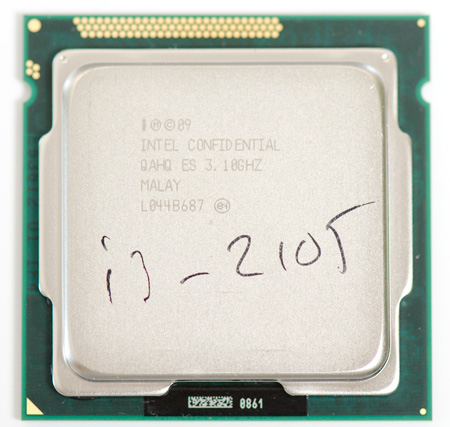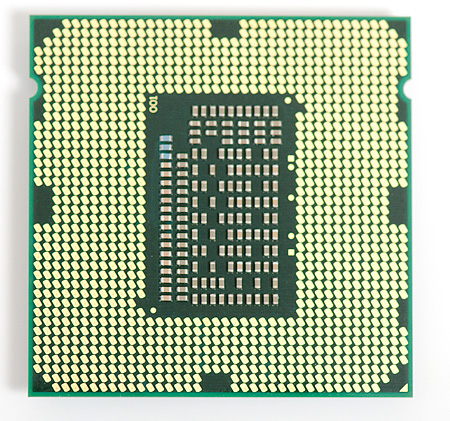The AMD A8-3850 Review: Llano on the Desktop
by Anand Lal Shimpi on June 30, 2011 3:11 AM ESTThe Direct Competitor: Intel's Core i3-2105
When Intel launched Sandy Bridge the only way you could get the faster integrated graphics option (Intel HD 3000) on the desktop was to buy one of the more expensive K-series chips. The logic didn't make a ton of sense given that lower priced systems are usually the ones that depend on integrated graphics. In the weeks before Llano's arrival however, we met a new member of the Sandy Bridge family - the Core i3-2105:

The 2105 is virtually identical to the 2100 it augments. It's still a dual-core processor (HT enabled) with a 3MB L3 cache . There's no turbo boost and you still get all of the same checkbox features (e.g. Quick Sync, VT-x, no VT-d, no AES-NI, etc...). There are only two differences between these two parts. The i3-2105 has an Intel HD Graphics 3000 core vs 2000 in the 2100, and the 2105 is priced at $134 (one dollar cheaper than the A8-3850).

It's clear that this HD 3000 equipped Core i3-2105 is intended to compete directly with the A8-3850.
The Test
The CPU tests in this review use an identical configuration to everything else in Bench (4GB memory, Intel X25-M SSD, discrete GPU etc...). The table below is for the processor graphics comparisons. All Intel HD 3000 numbers were generated using the Core i3-2105.
All discrete GPUs use our standard GPU testbed (3.33GHz Nehalem). This does prevent our usual efforts to keep our testbeds identical, however with low-end GPUs the contamination should be minimal as we’re GPU bound and then some, rather than being CPU bound.
| CPU: | AMD A8-3850 Intel Core i3-2105 |
| Motherboard: | ASUS P8Z68V-Pro (Intel Z68) ASRock A75 Extreme6 (AMD A75) |
| Chipset Drivers: | Intel 9.2.0.1025 AMD Catalyst 8.862 RC1 |
| Hard Disk: | Corsair P256 SSD (256GB) |
| Memory: | G.Skill DDR3-1866 2 x 4GB |
| Video Drivers: | AMD Catalyst 8.862 RC1 Intel 2372 |
| Desktop Resolution: | 1920 x 1200 |
| OS: | Windows 7 x64 |










99 Comments
View All Comments
evilspoons - Thursday, June 30, 2011 - link
Haha, I stupidly ordered a 1920x1200 panel in my work laptop (I really should've gone with 1680x1050).It's a 15".
Hahaha.
Alexvrb - Thursday, June 30, 2011 - link
You don't like your eyes very much, do you?misuspita - Thursday, June 30, 2011 - link
Oh come on, we come from the same place and that is not true. Budget systems come with the cheapest 19 LCD's which add 80€ to the price of a new budget PC. Resolution?1600x900.Yes, if you buy a second hand PC, then you get it with older monitors, but then, you don't get a brand new A8, right?
I also think that the resolutions tested should be max 3:
1. laptop minimum - 1366x768
2. LCD medium - 1600x900
3. LCD standard - 1920x1080
Musafir_86 - Thursday, June 30, 2011 - link
-Where are you from? I'm from Malaysia, and the place I mentioned is in context of a city (that's just a bit bigger than a town); in bigger cities the situation would be different, of course.-BTW, I meant a *NEW* budget system paired with a recond/refurbished monitors. CRT is offered to the most budget-constrained customers who would want a PC just for some word processing, surfing the internet, watching YouTube, and some light gaming for their kids. But more would prefer a LCD anyway, even if it's a refurb. :)
Regards.
misuspita - Thursday, June 30, 2011 - link
Sorry, your nickname is a word from romanian language, and I thought you are from Romania.Well, here new systems come with LCD's only, because they got really cheap in the past 5 years. And the cheaaaapest one still boasts a higher resolution than 1024x768. That's pretty ancient and not used anymore. Why do we not test in 640x480? I mean, safe mode works, we shoul test that one too...
L. - Thursday, June 30, 2011 - link
Again guys, we're reviewing new tech, the kind that costs a lot of money ... and stuff ..If you're into refurbished, I don't quite see the point of getting an i3 when you could get so much more out of second hand (pardon me, but in your position I'd rather spend 130 bucks on a full HD led-backlit LCD rather than a useless core i3).
ET - Thursday, June 30, 2011 - link
I'd argue for 1280x720 (720p) as the minimum resolution. That's a reasonable resolution to use as a step down on a 1080p monitor or HDTV.By the way, looking at Newegg, the lowest price monitors are either 1366x768 or 1440x900, then a couple of 1600x900 and then 1080p. The difference between in price between the cheapest 1600x900 and 1080p is $10.
Probably 1366x768 and 1080p are the only two resolutions really worth testing these days, since the market seems to be moving towards them as standards (much as I personally hate 16:9). Though I argued for 720p, the difference between it and 1366x768 is small.
BigDDesign - Friday, July 1, 2011 - link
1366x768 feels good with my eyesight and a 15" laptop. WTF is the problem with actually seeing what is on the screen at 2 feet away. 16:10 would be better, but we are stuck with cheap panels at 16:9. I wear glasses for the small stuff. Still don't think that a native resolution of anything less than a 24" monitor is good for 1080p resolution.stephenbrooks - Monday, July 4, 2011 - link
--[Still don't think that a native resolution of anything less than a 24" monitor is good for 1080p resolution.]--Yep, bought a 21.5" 1080p panel and it's pixels seem a little small for desktop use, suggesting 23-24" would be better. (Until all applications and OSes magically become resolution independent.)
zebrax2 - Thursday, June 30, 2011 - link
I disagree as many of lower end plasmas use 1024x768.